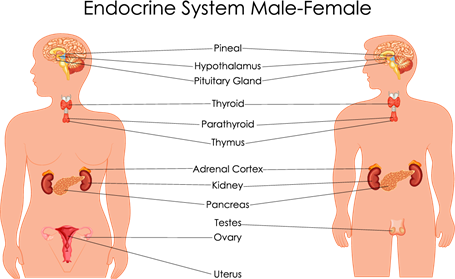
PUMPA - SMART LEARNING
எங்கள் ஆசிரியர்களுடன் 1-ஆன்-1 ஆலோசனை நேரத்தைப் பெறுங்கள். டாப்பர் ஆவதற்கு நாங்கள் பயிற்சி அளிப்போம்
Book Free DemoThe changes that take place in adolescence is controlled and caused due to hormones.
Hormones are chemical substancessecreted from the endocrine glands or endocrine system.
Hormones are responsible for changes in the human body at the time of puberty. They act as messengers that send signals. They are secreted in limited amounts that can cause changes in growth and development, behaviour, development of organs, puberty, etc. 
Endocrine glands
The endocrine glands release hormones into the blood that are carried throughout the body by the bloodstream. The hormones act on a specific tissue or organ called a target site. The target site responds according to the hormone. Thus, hormones act to regulate the target cells.
We have seen that the testes secrete testosterone. This means that testosterone is the hormone secreted by the endocrine gland testes. At the same time, estrogen is the hormone secreted by the endocrine gland ovaries.
The pituitary gland is also an endocrine gland attached to the brain that secretes hormones that stimulate the ovary and testis to produce sex hormones.
There is the presence of other hormones than sex hormones. Apart from the pituitary gland, other endocrine glands present in the body are the thyroid, adrenal, pineal, and adrenals.

Endocrine glands present in the body
Important!
Glands like sebaceous glands, sweat glands, and salivary glands release secretions through ducts. These glands are called exocrine glands. Endocrine glands release hormones directly into the blood and are thus termed ductless glands.
Role of hormones in reproduction
The primary hormones that regulate reproduction are steroids - androgens, estrogen, and progesterone. Androgens have masculinizing effects. Estrogen have feminizing effects. Progesterone have gestation effects.
These hormones are secreted from the gonads. The secretion of primary hormones is regulated by the anterior pituitary (adenohypophysis). Adenohypophysis is an anterior lobe of the pituitary gland that regulates several processes including stress, reproduction, growth, and lactation.
The male hormone called testosterone is released by the testes when puberty begins. The release of testosterone causes secondary sexual characteristics like hair growth on the face (moustache and beard).
The female hormone is called estrogen, which is produced by the ovary once puberty is reached. Estrogen is responsible for the development of breasts in girls. The mammary glands or the milk-secreting glands then develop inside the breasts.
In males and females, reproductive behaviour and reproduction controlled by LH (Luteinizing Hormone) and FSH (Follicle Stimulating Hormone). LH\ stimulates the testes to produce testosterone, the male sex hormone.
Sperms are then produced actively. In men, sperm production starts at sexual puberty and continues throughout life.
Follicle Stimulating Hormone (FSH)
FSH plays a vital role in sexual development and functioning. In females, FSH influences the development of the Graafian follicle and the secretion of estrogen. FSH helps in the control of the menstrual cycle and stimulates the growth of eggs. In males, FSH is necessary for the development of seminiferous tubules and spermatogenesis.
Luteinizing Hormone (LH)
Functions of LH in females
- Stimulates the steroid hormone released from the ovaries
- Stimulates ovulation
- Stimulates the secretion of progesterone
- Required for the final maturation of the Graafian follicle.
Functions of LH in males
- Stimulates the interstitial (Leydig) cells of testes to promote the production and secretion of testosterone.
- Since the secretory activity of the interstitial cells is stimulated by LH, it is also referred to as the Interstitial Cell Stimulating Hormone (ICSH).
- It is responsible for the production of sperms.
- It helps to maintain spermatogenesis and the development of secondary sexual organs.
Important!
Estrogen is not a single hormone. It is a collection of related steroid hormones. Three major physiological forms of estrogen are present in females - estrone (E1), estradiol (E2) and estriol (E3).
Prolactin (PRL) or Lactogenic Hormone
Prolactin is a hormone that is produced in the pituitary gland. This hormone's primary function is milk secretion during lactation and the development of mammary glands within the breast. It also takes part in the synthesis of milk protein - casein and lactalbumin.
Oxytocin Hormone
Oxytocin causes the expulsion of milk from the breast. It also aids in the contraction of smooth muscles of the uterus during childbirth.
There is the presence of hormones other than the sex hormones.